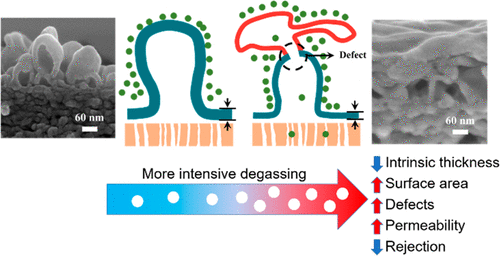当前位置:
X-MOL 学术
›
Environ. Sci. Technol.
›
论文详情
Our official English website, www.x-mol.net, welcomes your
feedback! (Note: you will need to create a separate account there.)
Intrinsic Nanoscale Structure of Thin Film Composite Polyamide Membranes: Connectivity, Defects, and Structure-Property Correlation.
Environmental Science & Technology ( IF 10.8 ) Pub Date : 2020-02-26 , DOI: 10.1021/acs.est.9b05892 Xiaoxiao Song 1, 2 , Bowen Gan 1 , Saren Qi 3 , Hao Guo 4 , Chuyang Y Tang 4 , Yong Zhou 1, 2 , Congjie Gao 1, 2
Environmental Science & Technology ( IF 10.8 ) Pub Date : 2020-02-26 , DOI: 10.1021/acs.est.9b05892 Xiaoxiao Song 1, 2 , Bowen Gan 1 , Saren Qi 3 , Hao Guo 4 , Chuyang Y Tang 4 , Yong Zhou 1, 2 , Congjie Gao 1, 2
Affiliation

|
Transport of water, solutes, and contaminants through a thin film composite (TFC) membrane is governed by the intrinsic structure of its polyamide separation layer. In this work, we systematically characterized the nanoscale polyamide structure of four commercial TFC membranes to reveal the underlying structure-property relationship. For all the membranes, their polyamide layers have an intrinsic thickness in the range of 10 - 20 nm, which is an order of magnitude smaller than the more frequently reported apparent thickness of the roughness protuberances due to the ubiquitous presence of nanovoids within the rejection layers. Tracer filtration tests confirmed that these nanovoids are well connected to the pores in the substrates via the honeycomb-like opening of the backside of the polyamide layers such that the actual separation takes place at the frontside of the polyamide layer. Compared to SW30HR and BW30, loose membranes XLE and NF90 have thinner intrinsic thickness and greater effective filtration area (e.g., by the creation of secondary roughness features) for their polyamide layers, which correlates well to their significantly higher water permeability and lower salt rejection. With the aid of scanning electron microscopy, transmission electron microscopy, and tracer tests, the current study reveals the presence of nanosized defects in a polyamide film, which is possibly promoted by excessive interfacial degassing. The presence of such defects not only impairs the salt rejection but also has major implications for the removal of pathogens and micropollutants.
中文翻译:

薄膜复合聚酰胺膜的内在纳米尺度结构:连接性,缺陷和结构性能相关。
水,溶质和污染物通过薄膜复合材料(TFC)膜的传输受其聚酰胺分离层的固有结构支配。在这项工作中,我们系统地表征了四种市售TFC膜的纳米级聚酰胺结构,以揭示其潜在的结构-特性关系。对于所有膜,它们的聚酰胺层的固有厚度在10-20 nm范围内,比不常见的粗糙突起的表观厚度要小一个数量级,这是由于排斥层中普遍存在纳米空隙。示踪剂过滤测试证实,这些纳米空隙通过聚酰胺层背面的蜂窝状开口与基材上的孔良好连接,从而实际分离发生在聚酰胺层的正面。与SW30HR和BW30相比,疏松膜XLE和NF90的聚酰胺层具有更薄的固有厚度和更大的有效过滤面积(例如,通过创建次级粗糙度特征),这与它们的显着更高的透水性和更低的脱盐率密切相关。借助于扫描电子显微镜,透射电子显微镜和示踪剂测试,当前的研究揭示了聚酰胺膜中存在纳米尺寸的缺陷,这可能是由于过度的界面脱气而引起的。
更新日期:2020-03-05
中文翻译:

薄膜复合聚酰胺膜的内在纳米尺度结构:连接性,缺陷和结构性能相关。
水,溶质和污染物通过薄膜复合材料(TFC)膜的传输受其聚酰胺分离层的固有结构支配。在这项工作中,我们系统地表征了四种市售TFC膜的纳米级聚酰胺结构,以揭示其潜在的结构-特性关系。对于所有膜,它们的聚酰胺层的固有厚度在10-20 nm范围内,比不常见的粗糙突起的表观厚度要小一个数量级,这是由于排斥层中普遍存在纳米空隙。示踪剂过滤测试证实,这些纳米空隙通过聚酰胺层背面的蜂窝状开口与基材上的孔良好连接,从而实际分离发生在聚酰胺层的正面。与SW30HR和BW30相比,疏松膜XLE和NF90的聚酰胺层具有更薄的固有厚度和更大的有效过滤面积(例如,通过创建次级粗糙度特征),这与它们的显着更高的透水性和更低的脱盐率密切相关。借助于扫描电子显微镜,透射电子显微镜和示踪剂测试,当前的研究揭示了聚酰胺膜中存在纳米尺寸的缺陷,这可能是由于过度的界面脱气而引起的。































 京公网安备 11010802027423号
京公网安备 11010802027423号